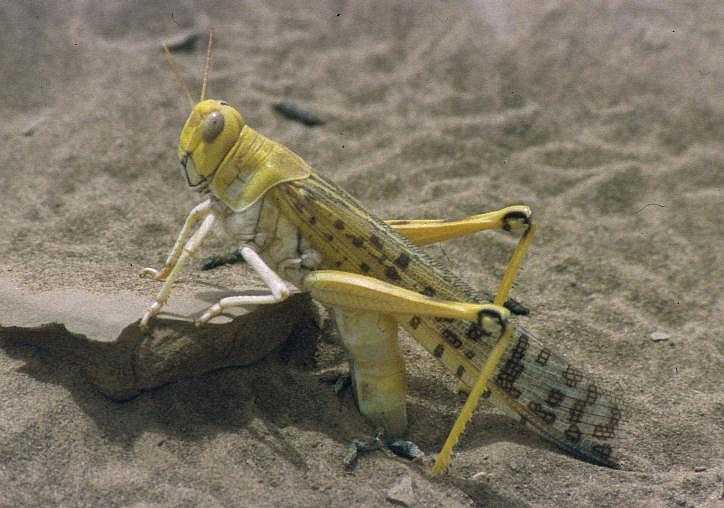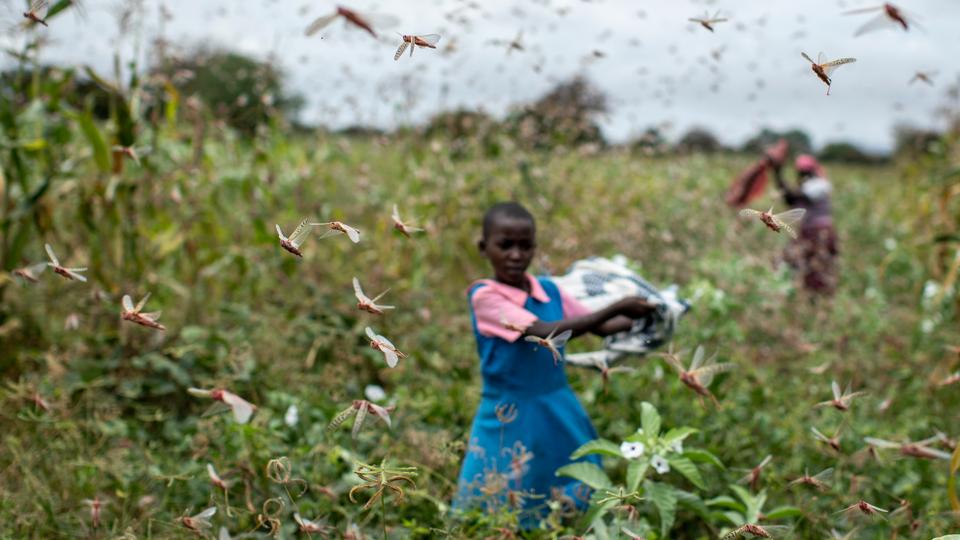Bright yellow and finger-sized locusts are grasshopper species capable of assembling in large destructive swarms and feeding on agriculture. These creatures currently prevailing in Africa, particularly East Africa, are a new disaster on its way. According to the International Rescue Committee (IRC), the desert locust swarms of East Africa are the worst outbreak witnessed in the past 70 years. Not to forget, the ongoing COVID-19 pandemic has wrapped the world around its fingers, with thousands losing lives every day. Loss of economy, business, security, quality of life, and loved ones is topped by the threat of these upcoming locusts swarms that can starve people of East Africa to death.
Why are these tiny creatures a threat to an entire region?
Their rapid reproduction and an exponential increase in numbers in a small frame of time make them a threat. The food and agricultural organization (FAO) states that each desert locust can consume approximately two grams of fresh food each day. Almost a 1000-meter swarm of desert locusts can eat the same quantity of food each day as a total of 35000 people will consume. Though it may not sound like an alarming scenario practically, these figures have drastic impacts on the agricultural crop that gets wasted due to these locust attacks.
Several locusts exist as listed below. However, among all these, desert locusts are the most minacious lot due to their rapid reproduction, the ability to migrate over long distances, and the capability of crop exhaustion and devastation.
- Desert locust
- Red locust
- Australian plague locust
- Rocky Mountain locust
- Patanga Succinct
- American bird grasshopper
Why is Africa prone to locust attack?
In Africa, almost 60% population residing below the poverty line; lack of infrastructure, overpopulation, impaired facilities, inadequate access to information and tools have worsened the situation. The land area covered by Africa is mostly utilized for farming purposes, but with such a pronounced threat of locusts’ attack lingering above their heads, the inhabitants of Eastern Africa are in a consequential state.
Though locust swarms exist all across the globe, Africa is the most vulnerable to these attacks in recent years due to three basic reasons.

Firstly, favorable weather is a crucial factor for attracting these locust swarms. Experts in Somalia and eastern Ethiopia have received higher than average rainfall during the rainy season (2020) that lasted for three months: September, October, and November. Plenty of rainfall indicates a fruitful agricultural output. An increase in crop production is the ideal breeding ground for locusts. The lush green vegetation covers a significant part of the land which means a greater number of breeding grounds for locusts for expanding their population and multiplying the members of their locust’s army. A report issued by the FAO (Food and agricultural organization) and the World Meteorological Organization claimed that the desert locusts could multiply massively. Within a year, there can be 160,000 times their initial population.
Rick Overson of Arizona State University’s Global Locust Initiative explained the behavioral changes in locusts when favorable weather conditions persist. “Instead of repelling one another, they become attracted to one another — and if those conditions persist in the environment, they start to march together in coordinated formations across the landscape, which is what we’re seeing in eastern Africa.”
Secondly, Cyclone Gati further fueled the growth and reproduction of locusts. One of the strongest tropical cyclones that hit the arid northern Somalia, Cyclone Gati resulted in an unexpected heavy rainfall in the region. This heavy rainfall turned the dry topography of northern Somalia into a reproducing ground for locust. It saturated the soil and made it the best fit for locust to lay their eggs and reproduce. Though the sudden propagation of vegetation could have been beneficial for locals provided that it was not being preyed upon by the intractable locust swarms.
Favorable temperature is another crucial factor that influences the life cycle of these creatures. In order for these locust eggs to hatch, a particular range of temperature in required. Flooding prior to the dry winters keep the soil moisture intact through the winters. This gives more time for the females to lay eggs hence increasing the population density of locust in the area.
Impact of Locust attack on Africa
The upcoming and previous locust attacks on Africa have posed grave concerns to the government and local population. According to World Bank, locust-related losses, including crop devastation, livestock, and others, sum up to $8.5 billion for the East Africa region and Yemen. In Ethiopia, early analysis depicts that desert locusts have caused the destruction of nearly 800 square miles of cropland, over 5,000 square miles of pasturelands, and a loss of more than 350,000 metric tons of cereal. This can result in approximately one million people seeking food aid and relief. In Africa, almost 24 million people are victims of food insecurity, and their locust swarm is predicted to lead to almost 5 million people facing starvation. Observing the severity of the issue, United Nations has warned that the people of Africa might reach a stage where they have to decide between migration or starvation.

Locust swarms coupled with climatic shifts and a deteriorating economy have further added pressure on the inhabitants of Africa. Masses are being displaced from their homes to safer areas. However, people traveling in search of food and water for their survival are in danger of being the victims of trafficking or, at worst, physical violence. This case scenario gets more serious when teenage girls and women search for food and water. When the available resources fall short, and there are more mouths to feed, it generates social pressure and disrupts family setups. With a larger population and limited in-hand resources, the competition amongst people stirs upon the fair division and utilization of the slim available resources. These situations can potentially worsen the existing crises and lead to greater damage.
Is there a way out?
The real question is that is there any possible way the severity of the locust situation in Africa can be controlled. There are proposed suggestions that may succor the pressure of locust attacks. Firstly, environmentally friendly biopesticides are required. This will reduce the number of invading locusts and will harm the environment to the least considering the arid and dry topography to Africa. Viewing the current situation in Africa, microbial biopesticides for instance fungus-based “Green Muscle” can prove to be a solution. Such biopesticides can be imported or aided from producing countries such as Netherlands or Japan.
Secondly, there is a natural way to diminish these creatures with respect to a particular region. Introduction of natural predators who prey on these dessert locusts can be environmentally friendly and fulfill the objective as well. Natural predators such as wasps, birds, and reptiles may prove effective at keeping mini swarms away.
Thirdly, eliminating the root cause is one of the best techniques to prevent the multiplication of swarms. Early preventative measures and effective management strategies to avoid greater losses can play a huge role in reducing their numbers and halt further such instances. Tracking the pattern movement of these adult locusts, especially the deadly desert locusts, is another useful strategy to prevent large-scale damages. In collaboration with United Nations, NASA is striving to arrest the expansion of locust swarms by intercepting the insects’ relationship with Earth’s climate. Employing space satellites to track the behavior of these insects, NASA scientists can learn how environmental changes influence locust populations, and the obtained information can help prevent future locust-derived disasters from occurring.
Africa is in dire need of support from all across the globe in these ongoing crises. Thousands of lives are at stake from the threat of hunger and starvation along with the COVID-19 pandemic. Neighboring countries should provide resources, medical supplies, food and water supplies, shelter, safety, and aid to enable Africa’s people to cope with such extreme conditions. It is time to keep aside political differences and work together as one body fighting to save humanity.
References:
- https://www.bbc.com/news/world-africa-55332142
- https://www.theguardian.com/global-development/2020/mar/04/scientists-turn-to-tech-to-prevent-second-wave-of-locusts-in-east-africa
- https://www.weforum.org/agenda/2015/11/how-can-we-control-locust-swarms/
- https://www.space.com/nasa-satellites-fight-locust-swarms-in-africa.html
- https://www.savethechildren.org/us/charity-stories/locust-outbreak-facts-causes
- https://www.weforum.org/agenda/2020/06/locusts-africa-hunger-famine-covid-19/
Also Read: Desert Locust– A Havoc to Agriculture

Maira Masood is a BS Biosciences student at NUST, Pakistan. She aspires to be a geneticist and wants to play an active part in spreading scientific awareness through writings.

